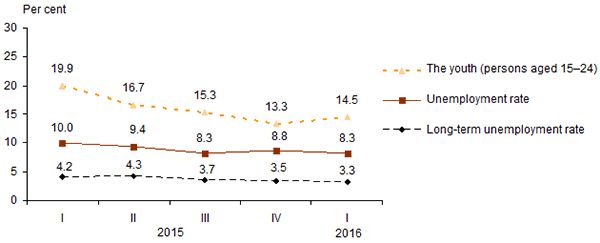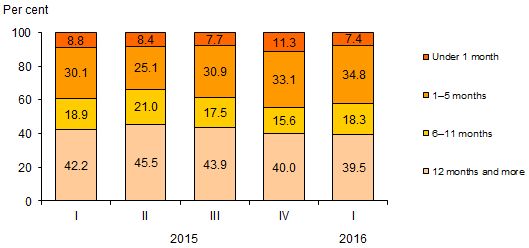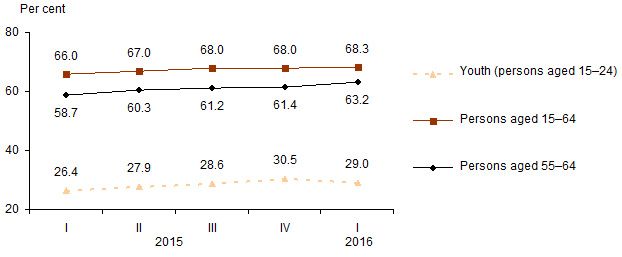Analytics, Employment, Labour-market, Lithuania, Markets and Companies
International Internet Magazine. Baltic States news & analytics
Friday, 19.04.2024, 04:39
In Q1, the unemployment rate in Lithuania decreased to 8.3%
 Print version
Print version
In I quarter 2016, the youth (persons aged 15–24) unemployment rate stood at 14.5%; over a quarter, it increased by 1.2 percentage points, while over a year – decreased by 5.4 percentage points.
In I quarter 2016, the long-term unemployment rate stood at 3.3%; over a quarter, it decreased by 0.2 percentage points, over a year – 0.9 percentage points.
 |
| Fig. 1. Unemployment rate in 2015–2016, by quarters |
In I quarter 2016, there were 122.5 thousand unemployed persons aged 15–74. Over a quarter, the number of unemployed persons decreased by 7 thousand (5.4%), over a year – 23.3 thousand (16%).
In I quarter 2016, there were 17.6 thousand unemployed persons aged 15–24; against IV quarter 2015, their number increased by 0.7 thousand (4.4%), and against the respective period of 2015, decreased by 7.1 thousand (28.8%).
Table 1. The unemployed, thousand
|
|
I quarter 2016 |
2015 |
Increase, decrease (–) |
||||
|
I quarter |
IV quarter |
I quarter |
IV quarter |
||||
|
thousand |
% |
thousand |
% |
||||
|
Total |
122.5 |
145.8 |
129.5 |
–23.3 |
–16.0 |
–7.0 |
–5.4 |
|
males |
69.6 |
80.7 |
68.4 |
–11.1 |
–13.7 |
1.2 |
1.7 |
|
females |
52.9 |
65.2 |
61.1 |
–12.2 |
–18.8 |
–8.1 |
–13.3 |
|
Youth (persons aged 15–24) |
17.6 |
24.7 |
16.9 |
–7.1 |
–28.8 |
0.7 |
4.4 |
The number of the long-term unemployed was 48.5 thousand, or 39.5% of the total number of the unemployed, which is by 3.3 thousand (6.4%) less than in IV quarter 2015 and by 13.2 thousand (21.4%) less than in the respective period of 2015.
 |
| Fig. 2. The unemployed by duration of unemployment, 2015–2016, by quarters |
In I quarter 2016, the employment rate of persons aged 15–64 stood at 68.3%; over a quarter, it increased by 0.3 percentage points, over a year – by 2.3 percentage points. The male employment rate of the said age group stood at 68.6, female – 68%.
Over a quarter, the employment rate of persons aged 20–64 remained almost unchanged – increased by 0.2 percentage points and stood at 74.2%.
In I quarter 2016, the youth (persons aged 15–24) employment rate stood at 29%; over a quarter, it decreased by 1.5 percentage points, over a year – increased by 2.6 percentage points.
In I quarter 2016, the further increase in employment rate of persons aged 55–64 was observed and stood at 63.2%. Over a quarter, it increased by 1.8 percentage points, over a year – 4.5 percentage points.
 |
| Fig.3. Employment rate in 2015–2016, by quarters |
In I quarter 2016, the number of persons classified under the labour force totalled 1 million 473 thousand; over a quarter, the number of such persons increased by 5.3 thousand (0.4%).
In I quarter 2016, there were 1 million 351 thousand employed persons. Against the previous quarter, the number of employed persons increased by 12.2 thousand (0.9%), against the respective period of 2015 – by 33.3 thousand (2.5%).
In I quarter 2016, there were 103.5 thousand employed persons aged 15–24. Over a quarter, the number of such persons decreased by 6.2 thousand (5.6%), while over a year – increased by 3.8 thousand (3.8%).
Table 2. Economic activity of the population aged 15 and older, thousand
|
|
I quarter 2016 |
2015 |
Increase, decrease (–) |
||||
|
I quarter |
IV quarter |
I quarter |
IV quarter |
||||
|
thousand |
% |
thousand |
% |
||||
|
Labour force |
1 473.3 |
1 463.3 |
1 468.0 |
10.0 |
0.7 |
5.3 |
0.4 |
|
Employed persons |
1 350.8 |
1 317.5 |
1 338.5 |
33.3 |
2.5 |
12.2 |
0.9 |
|
males |
652.7 |
647.8 |
655.4 |
4.9 |
0.8 |
–2.7 |
–0.4 |
|
females |
698.0 |
669.7 |
683.1 |
28.3 |
4.2 |
14.9 |
2.2 |
|
Unemployed persons |
122.5 |
145.8 |
129.5 |
–23.3 |
–16.0 |
–7.0 |
–5.4 |
|
Economically inactive persons |
989.5 |
1 032.2 |
1 001.5 |
–42.7 |
–4.1 |
–12.0 |
–1.2 |
In I quarter 2016, there were 989.5 thousand economically inactive persons aged
15 and older. More than half (56.4%) of them were old-age pensioners and
persons entitled to anticipatory old-age pension.
In I quarter 2016, there were 235.3 thousand (66%) economically inactive persons aged 15–24; 92.8% of them were studying at general, vocational schools, schools of higher education (colleges, universities).
Concepts
Unemployed persons– a non-working person of an established age (15–74 years) who has been actively seeking for a job (during the last four weeks) and is ready to start working in a certain period (two weeks).
Labour force – the total employed persons and the unemployed.
Long-term unemployed person – an unemployed person who has been
seeking for a job for one year or longer.
Long-term unemployment rate – an indicator expressed as a ratio of the
long-term unemployed to the labour force.
Inactive population – persons who are neither working nor seeking for a
job and who can be categorised as neither employed nor unemployed.
Unemployment rate – an indicator expressed as a ratio of the unemployed
to the labour force.
Employed persons – persons aged 15 and older doing any kind of work for
which they are remunerated in cash or in kind or have income or profit.
Employment rate – an indicator expressed as a ratio of the employed
persons of a selected age group to the total population of the same age.
The statistical information has been prepared based on the Labour Force Survey data. The survey is carried out in all EU Member States, using the same concepts and classifications, following the recommendations of the International Labour Organization, which makes its results comparable across the countries.
The survey has been carried using a sampling method. Over I quarter 2016, 12.7 thousand residents (0.5%) aged 15 and older were interviewed; the results were recalculated for the total population.
More information on the issue is available in the Database of Indicators of Statistics Lithuania.








 «The Baltic Course» Is Sold and Stays in Business!
«The Baltic Course» Is Sold and Stays in Business!

